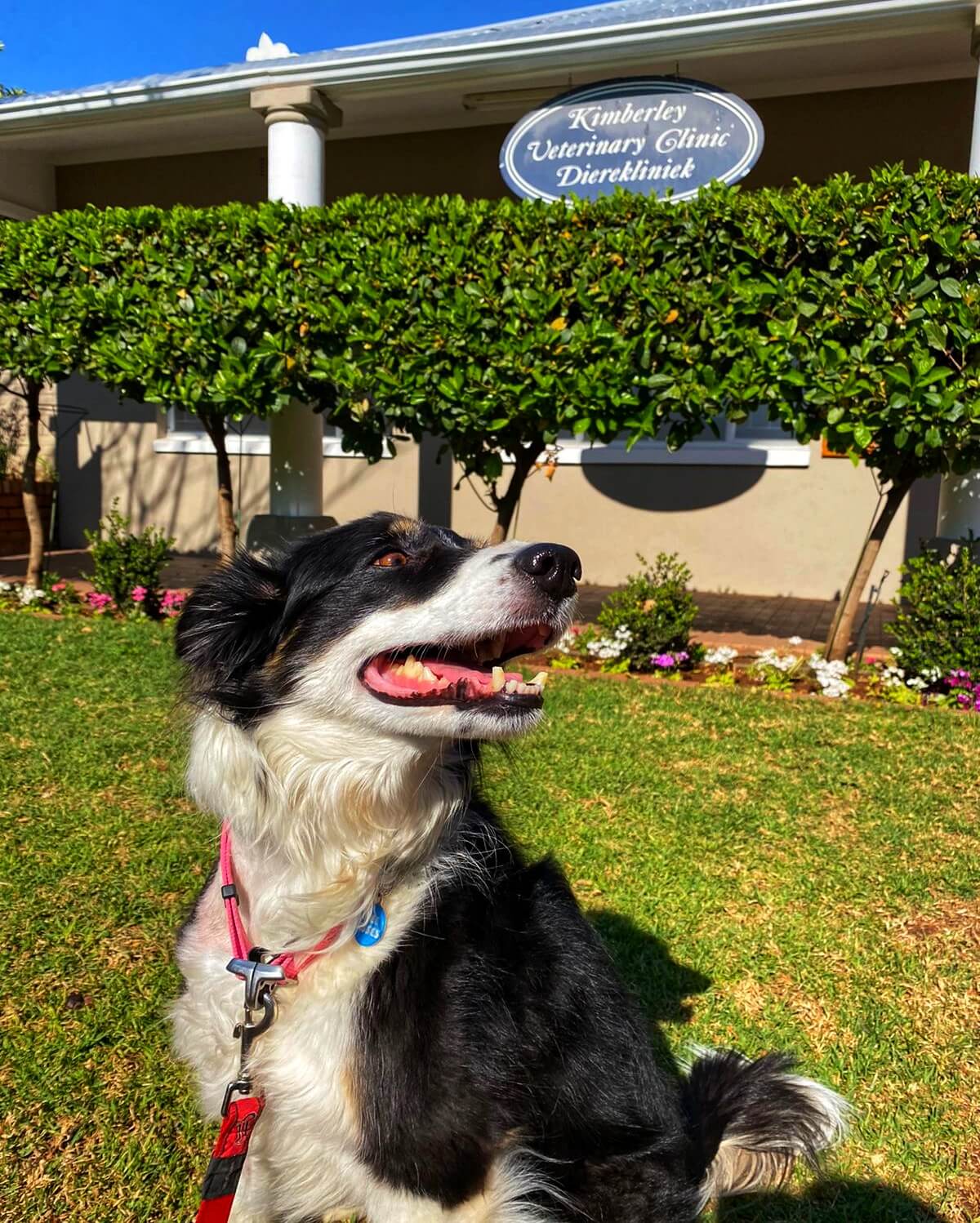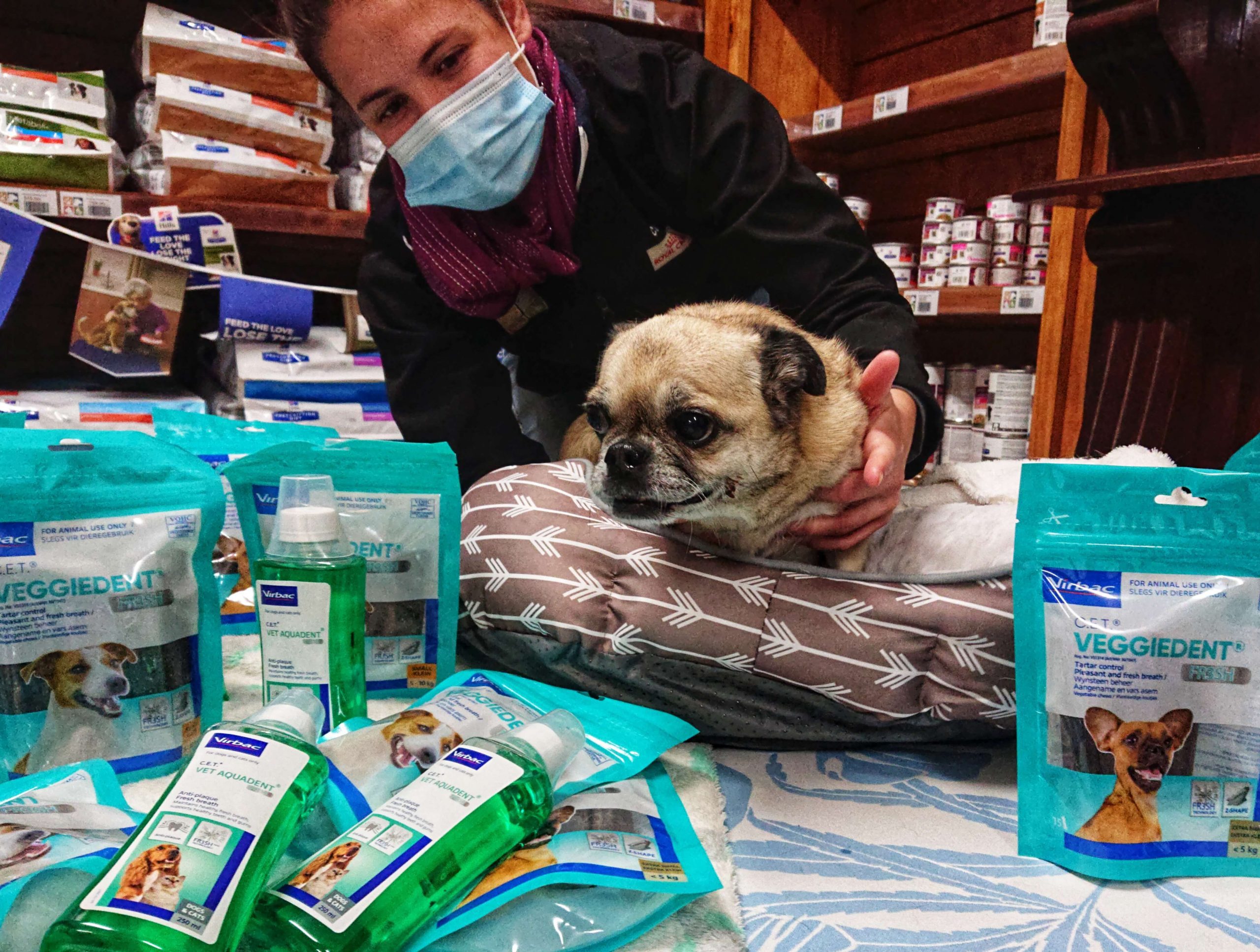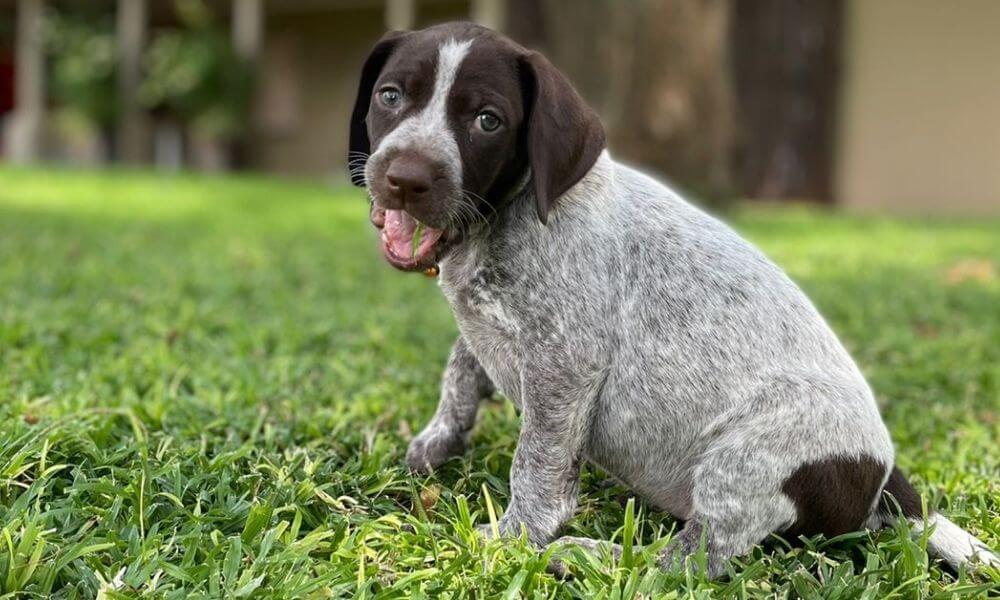Lesedi’s Story – Surviving Canine Parvovirus
Meet Lesedi
Meet Lesedi

Jessie the Border Collie is a working scent detection dog working in the field of conservation research. Over the past 7 years, the role she played in the research for elusive and endangered species has been paramount.
Unfortunately, in August Jessie was diagnosed with Lymphoma (cancer of the lymph nodes). Luckily, she has the most wonderful mom who will stop at nothing to make this miracle pup better. About two weeks ago, Jessie started her journey to recovery and is undergoing chemotherapy at our clinic. While this is a challenging endeavour, we are confident that, with all our efforts, the efforts of all her sponsors and all the unconditional love from her human family and supportive mom, there will be many more years of joy for Jessie. And hopefully, she will have some more time and energy to spare to continue her crucial research and conservation efforts.
Jessie started her career by sniffing out the scent of the Giant Bullfrog as part of a master’s degree study in Environmental Science at NWU. After this massive achievement, she started working with the Endangered Wildlife Trust in the field of conservation. Her focus was on the Critically Endangered Riverine Rabbit. (including a project for the National Geographic Society, be sure to check that out!)
In the last year, Jessie has also been involved in a study of Golden moles species on the West Coast of South Africa, funded by Re:Wild.
For more on Canine Lymphoma, check out our blog post: https://kimvet.co.za/jessies-story-surviving-canine-lymphoma/
For more information on her wildlife conservation, visit the EWT website: https://ewt.org.za/sp-aug-girl-power-2/
Not many people know much about service dogs, let alone what it takes to raise the perfect pup for the job.
Now, we all know that dogs, well, most dogs, are very intelligent. But just how intelligent are they?
A service dog is the epitome of intelligent. Not only that, but they are incredibly disciplined and their loyalty towards their person in unwavering.
I think we all will be shocked to know that you get a vast variety of service dogs.
Firstly, the most commonly known, the guide dog, these dogs help those who cannot see. Then you get a hearing dog, these dogs assist the deaf, and also the heroes who help people who are wheelchair bound.
On the other side of the spectrum, you get autism support dogs, you get emotional support dogs, and you get dogs who detect oncoming seizures.
You get those pups in the line of duty, Bomb sniffers, the dogs finding contraband and illegal substances, including rhino horn and pangolin scales!
Something very important to remember when encountering a working dog, although very cool, they are still working professionals. The job they do is extremely important.
ALWAYS ASK BEFORE APPROACHING, CALLING OR PETTING ANY WORKING DOG.
Even the simplest distraction could have detrimental results.
Any and all professionally trained working dogs are exclusions to the “No Dogs Allowed” rule.
Denying access to any working dog is an act of discrimination and is against the constitution. There are legal repercussions to anyone denying access to a working dog.
The one and only place a working dog is not allowed, is in an ICU ward.
Puppies start basic training at about 8 weeks old. They are trained in various disciplines from a very young age. There are different phases of the training process, so the pups will learn different and more difficult commands as they grow older.
Formal training starts at 16 months until about 2 years of age. That’s when they get paired with their new owner.
Of course, there are some puppies that aren’t going to be the perfect working dogs… But, don’t fear, the GDA has a special adoption system in place, their puppy raiser getting the obvious first choice.
While there are many different types of working dogs, the GDA mainly focuses on Guide Dogs, Service Dogs and Autism Support Dogs.
Raising a working dog is no easy feat and can cost thousands, depending on the individual needs of the puppy and relevant medical bills.
The puppies start off by being allocated to “Puppy Raisers”. At 8 weeks old they start basic training until about 16 months, thereafter formal training commences.
At about 2 years of age they are ready to be paired with their new owner.
Any differently-abled person who would like to have a working dog must first apply online. The staff at the GDA will work through the application and list of requirements.
The right match is made by analyzing the individual needs of the requesting owner and the attributes of the dog.
After a successful match has been made, training with both the dog and owner commences.
The first phase of training is completed at the Guide Dogs Association of South Africa head office, after which the next phase of training is completed at and around the owner’s home.
Successful navigation is a mixture of vocal cues and basic knowledge of the surroundings on the part of both the owner and the guide dog.
The guide dog’s training techniques, which includes traffic management, will ensure safe arrival at the intended destination.
Just like in any other career, working dogs also retire at a certain age.
Each dog is unique, so retirement can be anything between 8 – 12 years.
After a working dog has retired, they need to be re-homed. Their owners get obvious first choice in terms of adoption.
There is an adoption program for the adoption of retired working dogs, though. Any member of the public can adopt a dog after a vetting process has been completed.
The Guide Dogs Association (GDA) follows a responsible breeding program. They use specially imported semen from the US which is in turn used to inseminate their carefully selected brood females.
This procedure is done at Onderstepoort.
To ensure the best possible working dog, mentally and physically, they do not accept any dogs as “donations” for breeding or training purposes. The dogs that form part of the breeding program, as well as all the pups from the litters, are screened for hip and elbow dysplasia and basic bodily functions.
The GDA is not funded by the government. This means that they rely solely on donations and fundraising initiatives.
But the great news is, there are many different ways that we, as the public can support this incredibly important organization!
You can support their social events and competitions, you can have a look at their wish list to see what they need as donations and, of course, direct donations can be made, too.
They always need volunteers as well, like “Puppy Raisers”, to sponsor a working dog, walk the dogs in the kennels or weekend homers.
For more information on how to help the GDA, please visit the GDA website or contact them directly: https://guidedog.org.za/

Dental disease is a reality. Keeping your pet’s teeth clean is important to their overall health. Imagine how your teeth would look and feel if you didn’t brush them for years, or even just a few weeks!
Ever since cats and dogs became domesticated, their natural source of “dental floss” and teeth cleaning has been mostly removed from their diet. Canned and dried foods, the nutritional replacement for your pet’s traditional diet, does not provide the same level of oral hygiene.
Dental disease is an infection of the teeth, gums and surrounding structures. It is by far the most common major health problem of cats and dogs.
It starts with a build-up of plaque which eventually turns to tarter. This quickly forms small pockets where an animal’s gums meet its teeth. The gums can separate from the tooth and this allows more bacteria and food to accumulate. This build-up leads to periodontal disease. These pockets allow bacteria to enter the bloodstream. If left untreated, it will lead to more serious health problems like heart and kidney disease
Symptoms of dental disease include bad breath, lethargy, inactivity or depression, poor grooming, excessive salivating, inflamed gums, decreased or loss of appetite and weight loss. Other issues include dropping food while eating, facial swelling, discharge from the nose or eyes and pawing at the face. Sometimes the teeth just become so rotten that they become loose and fall out on their own!
The key to managing dental disease is prevention. Regular oral examinations and dental cleanings are recommended for all adult dogs and cats.
Daily tooth brushing is the best way to slow the onset of dental problems. Feeding dry dental diets or dental chews may slow down the development of recurrent periodontal disease, but it will not completely prevent it. Daily use of products like oral gels and rinses may aid in keeping your pet’s teeth and gums clean and healthy.
For more information on brushing your pet’s teeth, talk to one of our stellar veterinarians or reception staff about developing a dental care plan for your furry friend.

Feeding the right puppy food is super important!
Puppies are usually weaned when they are about 6-8 weeks old. The goal of feeding growing puppies is to lay the foundation for a healthy adulthood. Proper nutrition is needed to achieve healthy growth (neither too rapid nor too slow), optimise immune function, minimise potential for obesity and avoid developmental orthopaedic disease.
Puppies grow quickly. Growth rates for puppies vary by breed. Small and medium breeds mature to adulthood by the time they are 10-12 months of age, and 18-24 months for large and giant breeds. Growth involves a complex process of interactions among genetics, nutrition and environment. Proper nutrition is critical to the health and development of puppies, regardless of breed. There is a massive difference between small, medium and large breed puppy food. It is of the utmost importance that large breed puppies are on a large breed puppy diet! The breed of the dog will be indicated on the packaging. The exact amount that needs to be fed daily will also be specified on the packaging. Be sure to follow those guidelines so you won’t over- or underfeed your pup.
An optimal growth rate in puppies is ideal. It is a slow and steady growth rate that allows the puppy to achieve an ideal optimal adult body condition while avoiding excessive weight.
Growing puppies need higher amounts of all nutrients in comparison to adult dogs, but excess energy and calcium can create serious problems. In small to medium breeds, excess energy can lead to obesity. In large and giant breeds, excess energy and calcium can also lead to abnormal skeletal development.
Optimal feeding must begin during the weaning stage and continue through to adulthood and old age.
Poor nutrition can have life-long repercussions, setting the stage for many complications and diseases. These include hypertension, heart disease, diabetes mellitus, osteoarthritis, heat intolerance and decreased immune function.
Free-choice feeding increases the risks for higher levels of body fat, leading to obesity, and, especially in large breed puppies, skeletal abnormalities. Puppies grow rapidly and should be fed measured amounts at regular feeding times, generally 3-4 times per day, based on their body condition and age.
Your puppy’s weight, body condition and growth rate should be regularly assessed. With planning and attention to detail, you can lay the foundation for your puppy’s optimal health and longevity.

Dealing with the loss of a pet can be very difficult. Experiencing the death of a pet can come without notice. Things happen that are unexpected and incredibly painful. When we open our hearts and our homes to our furry, or not so furry, family members, pets and animal companions, we have hopes of a full, happy and healthy life for each of us.
Mostly, that is the case, but sometimes we don’t get that opportunity. Experiencing the death of a pet that is unexpected, sudden and tragic can leave a profound impact on us. So many times we can place unfair guilt on ourselves for the experience, blaming ourselves for what has happened.
Grief isn’t easy when it is expected and is even harder when it is not.
A common phrase we hear among the grieving is that one needs to “find closure”, but convoluted feelings arise when faced with ‘incomplete’ grief experiences. The truth is, many times we as pet owners cannot experience “closure” before being faced with the death of a pet.
Within the grieving process, our brain attempts to make sense of this profound experience. We try to believe that things happen for a reason, even if that reason leads us to blame ourselves. When something goes wrong, it is extremely important to remember that we didn’t plan for it to happen.
Guilt is a powerful emotion that has a huge impact on our lives, consciously and unconsciously. Guilt makes us punish ourselves. Throughout the grieving process, we place a massive amount of guilt upon ourselves. This pressure, this guilt, leads to an increase in anxiety and even feelings of panic. We need to remember to allow ourselves to process through our emotions in a healthy way.
It can be easy to lose control quickly when we, consciously or subconsciously, place more and more pressure on ourselves. We can easily feel burdened, overwhelmed and feel that we are unable to meet our daily needs throughout the grieving process.
If you feel this happening to you, it can be helpful to ask ourselves, ”What would my pet want for me?”. Would your pet want you to blame yourself, or would they be understanding with you? Would they want for your happiness regardless of what happened? I would say so, without any hesitation. That’s just how amazing our pets are.
Remember, it is completely normal to experience many different emotions in the beginning of, and throughout the grieving process, especially when it comes to facing the sudden death of your pet.
It is important to experience healthy distractions. A healthy distraction could be as simple as a walk through the park. It may be a close, understanding friend taking us out for coffee and laughing about something small. It may be when you’re reminiscing of fond memories of your pet and smile – it is so important to talk about what you are feeling.
These distractions are fundamental and allow us, even if just for a moment, to unburden ourselves. Grieving is hard work, it is extremely taxing on our body, but it is also a crucial thing to experience.
If you take no other advice from this, remember that grief is a moment-to-moment process. It can be too hard to ask for even one day at a time, because a day can seem endless when we feel overwhelmed by our grief.
Remember that in this moment and with every emotion our body is processing through our grief. Please know that you are not alone. We are always here for you.
For more resources on how to cope with your pet’s death, please read this petMD article – https://www.petmd.com/dog/care/coping-your-pets-death-important-guide